Kayaking can be a relaxing activity for you, your family, your friends, or even your dog. However, not everyone has the luxury of living next to a lake or river. If you are in need of something to transport your kayak from your home, then you are in luck as we will be reviewing the best kayak roof racks available in today’s market.
Hopefully, this review will help you find a roof rack that will fit your specific needs. With the right choice, you can take your kayak wherever you go with ease, style, and safely.
Table of Contents
Best Kayak Roof Racks Reviews
01 Malone J-Downloader Folding Carrier (Top J-Cradle Model)
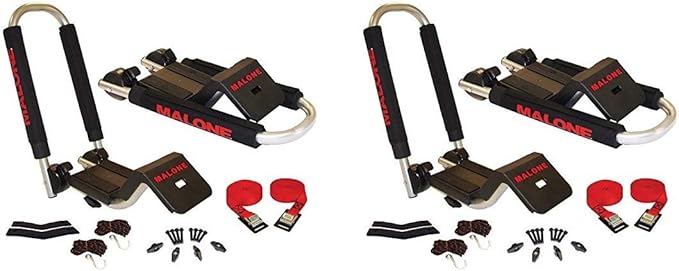
If you want an easy load choice, then the Malone Downloader Folding J-Style is the most reliable choice available based on our extensive tests. This model quickly became our favorite as it took little effort to attach and secure a kayak to this particular rack. This is because of the built-in boarding ramp which makes loading and unloading kayaks an easy one-man job. This will ensure that your kayak will stay in place even when going through uneven terrain.
Aside from this, you can also purchase the MPG351 Telos Load Assist as this is compatible with the Malone Downloader. Why this type of technology would not be integrated, though, is anybody’s guess. As of compactness, the Malone Downloader weighs only 10 pounds but is capable of carrying kayaks up to 75 pounds in weight. The cradles can also be folded, allowing you to store more and clearing up your vertical space.
The Malone Downloader is adequately padded with thick material covering all relevant areas, providing additional protection not only for your kayak but for your vehicle as well. The Malone Downloader includes load straps and buckle protectors for added security and protection.
Lastly, the patented JAWZ mounting hardware promised that the Malone Downloader can easily be installed with almost all types of factory-fitted crossbars whether they are rounded, square, or oval. We found this to be extremely helpful during our tests, and the 60 and 70mm mounting bolts included in the package really helped in completing a snug install for most, but not all, crossbars that were available at the time of testing.
Specifications
- Size (inches) 21 x 10 x 8
- Weight (pounds) 10
- Style J-Style
- Foldable? Yes
- Weight Limit (pounds) 75
- With Ramp? Yes
Pros
- It can fit different shapes of crossbars
- It provides ease of loading for a J-style cradle
- It provides excellent kayak and vehicle protection
- It can be folded to access additional space
- It can carry heavier kayaks with ease
Cons
- Load Assist does not come with the package
- The cradles wiggle for irregularly shaped crossbars
Final Verdict
The Malone Downloader should be one of your top choices if you want a J-cradle. It is resilient, and while it will function great in a small car, it can also be an excellent choice for SUVs, the new market dominators. It provides a fast loading and unloading process and you don’t have to strain yourself with the boarding ramps attached.
While there are a few flaws to the “universal fit” label, it does cover the most common crossbar shapes. However, there’s nothing a simple phone call to Malone customer service to verify if the Downloader is right for your vehicle.
02 Thule Hull-a-Port XT

The Thule Hull-a-Port XT is an awesome-looking kayak carrier with a minimal installation system and low wind noise. The versatile rooftop rack clamps in two places to securely hold your kayaks. It’s also easier to remove from the roof than many other rivalries.
The strap-mount carrier has clamps that hold it to the bar on the roof. You get one set of straps so it’s better to get extra straps for the 2nd kayak or highway drives. The straps may pop out of the slot so you need to hold them with tension.
The XT rooftop carrier is durable and lightweight. The installation process is straightforward and practical but you will need two people for the job. The strap holders are strong but you need to put them in the right place before loading the kayaks. The Thule may shift to a side when you drive on a windy highway. You only need to push it back and tighten it further to solve this problem.
The rigid tool remains locked on the roof and holds your kayaks well. It’s stable and makes no wind noise when you drive with two kayaks on the roof. The high-quality material is easily distinguishable from cheaper products in the market. The straps don’t harm the paint or finish of your vehicle when tied down. The plastic covers for metal edges also protect your vehicle from any damage.
The supplied straps keep your kayaks in place without being too tight. You only need 15 to 20 minutes to load and secure them on the rooftop carrier. If you are short, a milk crate or something like that height will help you stand and reach the top. Make sure the fit isn’t too loose or your kayaks will move. You also don’t want it to be too tight to avoid problems with the rack and mounts. Once you unload the kayaks, you can fold down the arms for a sleek look.
Specifications
- Dimensions: ?20 x 9 x 20 inches
- Weight: ?12.5 pounds
- Color: Black
- Load capacity: 130 pounds
Pros
- Straightforward installation and removal processes
- Foldable design
- Aesthetically pleasing design
- Low wind noise
- Doesn’t harm the finish/paint
Cons
- Camlocks may slip a little when driving
- Bottom plastic pieces are not good for strapping
Final Verdict
The Hull-a-Port XT works perfectly since the bolts don’t hang down under the crossbar. The folding arm feature is lovely and gives your vehicle a slim look. It’s a good product at a reasonable price and better than cheaper alternatives.
The rack doesn’t budge after a 10-hour drive with the kayaks loaded. This is a solidly-built item that will serve you a long time.
03 HandiRack Universal Inflatable Bars (Top Pad Roof Rack)

The HandiRack Universal Roof Rack Bars are inflatable pads that take less than 15 minutes to install. It is made of durable material that is strapped on top of the car and inflated with a pump that comes with the package.
One good point about the HandiRack is that it sports a rated load capacity of 180 pounds. That is enough for two kayaks. It is also versatile as it can carry items other than kayaks such as coolers, camping gear, surfboards, or any other items that can rest on the pads during travel.
One drawback, on the other hand, is the lack of built-in braces in the HandiRack. You would have to rely on tight straps that you would have to fix from time to time, so you should expect minor stability issues, especially when traveling at high speeds.
Still, the HandiRack is a great alternative you have if you don’t want to install rails or crossbars on your vehicle. It provides adequate protection as a first option, but it doesn’t seem to be a viable long term plan for frequent kayakers. This, however, is great for those who find themselves carrying kayaks or similar large objects for just a handful of times a year, as the HandiRack can be easily installed and removed as needed.
This is recommended for those who have not yet decided to have permanent crossbars installed. The HandiRack is also great for those who use multiple types of cars for transport as it can fit all vehicles up to 55 inches in width.
Specifications
- Size (inches) 38 x 35 x 9.5
- Weight (pounds) 6.4
- Style Pad
- Foldable? Yes
- Weight Limit (pounds) 180
Pros
- It is easy to install
- It does not require crossbars to install
- It can carry a lot of weight
- It can be used for items other than kayaks
- It is compatible with all types of vehicles
Cons
- Stability can be a concern due to lack of ramps and loosening of tie-downs
- Accidental deflation could damage your car
Final Verdict
The HandiRack Universal takes the cake when it comes to versatility and durability, although it falls a little bit behind when it comes to convenience in loading and unloading kayaks. There’s nothing a few extra tight binds cannot fix, however.
Buy this item if you do not have any fixed requirements or plans to invest in more permanent solutions. It is a great temporary solution, but should not be relied upon long term if you are a serious kayaker.
04 Thule 830 The Stacker (Top Stackers Roof Rack)

For those who require easy lift kayak car racks for 2 kayaks or more, you should look no further than the Thule 830 The Stacker Kayak Rack. Based on our reviews, it is the right choice when it comes to carrying multiple kayaks at once. Also, since it is made in the USA, you can be guaranteed of its quality and durability.
The Stacker can easily be attached and detached from crossbars as they are only screwed in, although you might need to check if this is compatible with your vehicle. The Stacker can be folded down if it is not in use, and it can support up to four kayaks with a maximum weight of 600 pounds. Don’t expect it to be a one-man job though, as the product does not offer load assist. Also, keeping your kayaks on their sides while you tie them down will definitely require a partner to accomplish.
The Thule 830 is the most economical way to transport 4 kayaks, but it can be an expensive investment if you would only be using it for 1, 2 or 3 kayaks as there are other alternatives around that are cheaper. For maximum number and weight capacity, however, nothing beats The Stacker, although load straps for up to four kayaks should have been already included in the package and should no longer be an optional purchase. Still, this is your best bet if you want a durable, secure, and nicely arranged stack of kayaks on your car’s roof. Nevertheless, unlike the Stacker 520 model, it’s a foldable model for saving space.
Specifications
- Size (inches) 22 x 6 x 6
- Weight (pounds) 6.4
- Style Stacker
- Foldable? Yes
- Weight Limit (pounds) 600
Pros
- It allows you to secure up to four kayaks on top of your car
- The folding design saves space when it is not in use
- It can be installed easily on crossbars
- It is lightweight and durable
- It has the highest load capacity at 600 pounds
Cons
- Included straps are enough for one kayak only
- Two people are required to load
Final Verdict
Thule’s The Stacker should be purchased if you intend to carry at least two kayaks at a time. Otherwise, you’re better off looking for something else, especially if your budget is of any concern.
The Stacker, though, at maximum capacity performed well, even with differently sized kayaks loaded. In performance, it can outperform the Thule 884 model. However, make sure that weight distribution is properly balanced to ensure safer travels. With balanced and secure kayaks, the Thule 830 blows everyone else out of the water when it comes to carrying convenience. Get it to explore the most exotic water bodies in various corners of the country where you can enjoy kayaking with your loved ones.
05 Malone SeaWing Saddle Rack
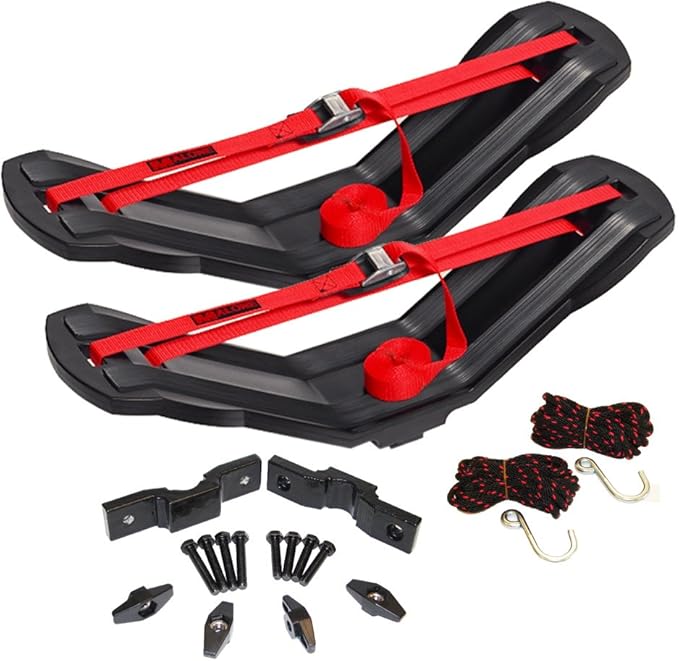
The Malone SeaWing Saddle Style topped our reviews for the saddle category as it provided one of the most secure rides that we have experienced. The SeaWing has flexible cradles that hug most kayak frames. This not only secures the base snugly but also minimizes drag, which in turn improves fuel efficiency.
The SeaWing also has the patented JAWZ mounting hardware, which promises that it fits most if not all standard crossbars. Its low profile design also takes up little space, allowing for up to two saddles to be placed on wider vehicles. However, you might be put off by the rocking motions of the kayaks during transport, but this is entirely normal and you’ve to take the trouble to enjoy your time on the waters.
Loading straps with buckle protectors are included in the package, and these provide your racks with a snug fit while still allowing for ample space to protect your vehicle from scratches and bumps. Despite not being foldable, it is unobtrusive and can not be removed even when it is not in use.
At over 120 dollars, you can find a lot of other similar racks, but the Malone SeaWing wins the title for the top saddle type choice because of the safety and security it provides. Rollers may also be needed to assist in loading, something that the SeaWing sadly lacks. For a classy looking rack that is easy to install and requires little effort when loading and unloading, this is money well spent for the convenience that it brings.
Specifications
- Size (inches) 27 x 5 x 6
- Weight (pounds) 10
- Style Saddle
- Foldable? No
- Weight Limit (pounds) 70
- With Ramp? No
Pros
- It supports the entire bottom of the kayak
- It can fit most available crossbars in the market
- It is easy to load and unload kayaks
- Kayaks are safely secured
- It uses up little roof space allowing for another rack or extra storage space
Cons
- It can be quite expensive
- It is not foldable when not in use
Final Verdict
The Malone SeaWing Kayak Carrier performed really well as it was able to carry our sample kayaks really well with a little loosening of straps. Expect slight rocking movements, however, but that is completely normal. The SeaWing is one of the safest kayak racks that we have tested, even if it loading it can be a chore for smaller users without rollers.
For transport safety, however, nothing beats the Malone SeaWing in its class, making this our top choice.
06 TMS J-Bar Rack HD Kayak Carrier
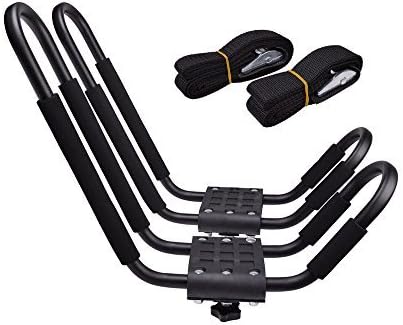
One of the most affordable yet quality products in our list is the TMS J-Bar Kayak Carrier. Though priced at less than 30 dollars per pair, the J-Bar is not made cheap. It is made of steel which provides a durable and stable frame for your kayaks, and adjustable foam pads on the rails will provide your kayaks with the added protection that it needs, regardless of size.
The J-Bar can accommodate kayaks of up to 75 pounds and up to 36 inches wide. This is great for those who carry big kayaks across long distances as our tests have shown good performance when it comes to stability even when traveling at high speeds.
The TMS J Bar also has a wide mouth not only to accommodate larger kayaks but also to make loading easier. Unfortunately, the rack does not provide a loading ramp which would have made the loading process much easier. For shorter people or those who lack physical strength, this may pose a problem.
Designed to fit all types of crossbars, we did not have any trouble installing the J-Bar. However, you might experience wiggles but for as long as the rails are secure and the straps are tight, you wouldn’t have any issues about the kayaks dislodging during travel.
If you have kayak transport needs but do not want to splurge on a rack, then the TMS J-Bar can address your needs. You can get top-quality performance without burning a hole in your wallet with the J-Bar.
Specifications
- Size (inches) 18 x 7 x 7
- Weight (pounds) 10
- Style J-Style
- Foldable? No
- Weight Limit (pounds) 75
Pros
- It is durable with steel construction
- It is affordable
- It is easy to install and remove
- It can accommodate wide kayaks securely
- The pads can be adjusted
Cons
- It is not foldable
- It does not have a loading ramp
Final Verdict
With a sturdy design, stable frame, and a low price, the TMS J-Bar Kayak Carrier is the best kayak roof rack for those who know how to properly load and unload a kayak but do not want to fully invest in the equipment needed.This is because loading and unloading will take some skill and strength as most J-style kayak racks do, but you will definitely get what you pay for with this product. Besides, you can always ask for help that should come free. Overall, we’ve got good reasons to call it one of the best kayak racks that money can buy. You can’t really go wrong buying it.
07 Yakima Jaylow Kayak Carrier

If you would look at dual kayak roof rack reviews, you might not find the Yakima Jaylow Kayak Carrier among them. However, know that the Jaylow can definitely carry two kayaks at a time due to its innovative design that allows you to carry one kayak J-style or two stacker style. The Jaylow can also be folded so that it will save up on vertical space when not in use.
Extra paddings in the Jaylow allow for a snug fit for kayaks and provides added protection as well. The package comes with straps and tie-downs that are good for one kayak only, so you would have to buy additional straps if you need to carry more than one kayak around.
While the fits for two kayaks are snug, our test has shown that traveling at high speeds may cause the structure to emit a high pitched noise due to wind passing through it. It’s quite negligible, though, especially with the windows rolled up.
The Jaylow Kayak Carrier is compatible with most crossbars, but you would have to be a bit creative in tying down your kayaks in some cases. That’s a small price to pay considering the flexibility and adaptability of this rack.
Priced at around 200 dollars, the Yakima Jaylow is not an inexpensive option, but as it is built to last, this can be considered as a good buy especially for regular kayakers that love to travel. As it is also highly compatible, you can easily detach and install the structure to another vehicle if ever you would be purchasing a new car somewhere down the line.
Specifications
- Size (inches) 20.2 x 10.4 x 7.8
- Weight (pounds) 12.7
- Style J-Cradle/Stacker
- Foldable? Yes
- Weight Limit (pounds) 80 for 1 kayak, 110 for 2 kayaks
Pros
- It can switch from 1 to 2 kayak storage easily
- It is foldable, saving you space
- It is adequately padded for protection
- It provides a universal fit for crossbars
- It is easy to install and remove
Cons
- You might experience wiggling for few types of crossbars and kayaks
Final Verdict
The Yakima Jaylow is a good buy for long term use and so you won’t have to think about buying another kayak in near future. It is highly adaptable and you would not have to purchase anything new aside from new straps should you decide to carry two kayaks instead of only one.
It also provides ample space between your kayaks and your car, so you are sure that they will be free from damage during loading and unloading.
08 Thule 898 Hullavator Pro Kayak Lift System

Our kayak roof rack reviews would not be complete without the Thule 898 Hullavator Pro Kayak Lift System. A play on the word “elevator,” the Thule 898 Hullavator basically elevates your kayak from the side of your vehicle up to the roof. Gas struts allow for an easy loading and unloading process as it takes up to 40 pounds off the kayak’s weight, allowing you to easily push and pull as needed.
The Hullavator is capable of carrying hulls up to 36 inches wide and up to 75 pounds, although not all hull sizes can be accommodated securely. When strapped down, you can really feel how well kayaks are stored, making travel easy and convenient even with heavier kayaks. Eight padded areas ensure a snug fit as well as protection for your vehicle against scratches.
The Hullavator is also beautifully constructed with both sturdiness and anti-corrosion in mind. It can be quite difficult to install, though, but the actual cradles can be easily removed once the entire frame has been attached. Of course, this means that the cradles themselves can be open to theft. In this regard, locks can be purchased for an additional cost. The Thule Hullavator also fits most crossbars with different mounting options available.
The Thule Hullavator is one of the most expensive kayak racks that you will see, but it is well worth the price as literally anyone can perform loading and unload with ease. Eyes will definitely be on you as well as this is one of the most visually appealing racks that you will see out there today.
Specifications
- Size (inches) 36 x 6 x 16
- Weight (pounds) 34.7
- Style Saddle, Lift & Load
- Foldable? No
- Weight Limit (pounds) 75
Pros
- The system allows for easy loading and unloading
- The cradles are removable when not in use
- Padded areas provide superior protection against scratches
- The product is designed to last for a long time
- It has a unique and luxurious look
Cons
- Installation can be difficult
- It does not accommodate kayaks with narrower and more pointed hulls
Final Verdict
If you want unparalleled ease in loading and unloading, then look no further than the Thule 898 Hullavator. Storage and removal take seconds, and even a child can safely use the rack. It also provides superior security on top of the convenience, giving you the best of both worlds in the process.
The price may put off those concerned about their budgets, but the regular kayaker will surely be able to make the Hullavator worth the money as it was constructed and built to last.
09 Malone J-Pro 2 J-Style Universal with Bow & Stern Lines
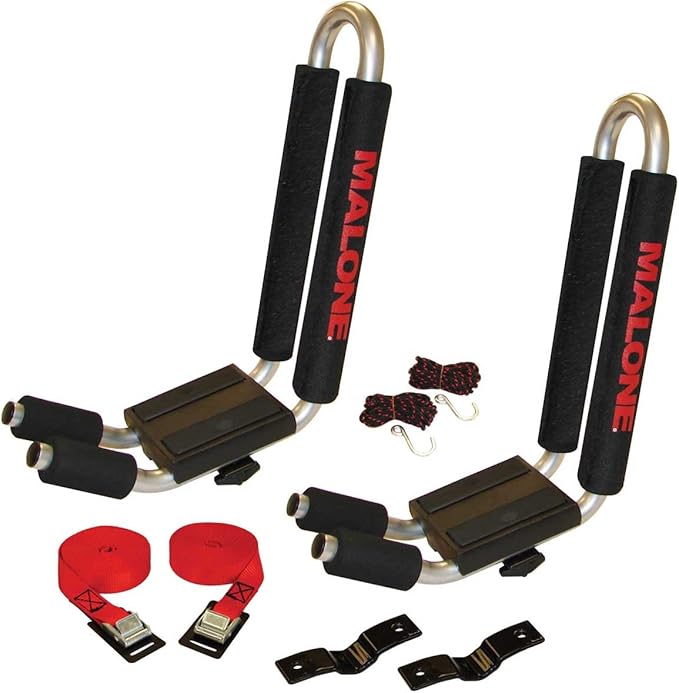
An upgrade to Malone’s J-carrier, the J-Pro 2 employs enhancements that prove better kayak support. These include additional soft foam paddings and a more flexible cradle that will allow it to carry a wider range of kayaks up to 75 pounds.
The Malone J-Pro 2 also employs its JAWZ mounting hardware along with bolts that will allow it to fit most if not all types of crossbars. Tie-downs and buckle straps allow you to safely secure your kayaks at high speeds and even in the harshest of driving conditions. This rack allows for more convenient loading as well due to an integrated boarding ramp. As such, sliding kayaks into place will be possible allowing for an easier loading process.
The J-Pro 2 is not only built to last with corrosion-resistant steel, but it also comes with a lifetime warranty. Many have reported usage of up to five years without any problems, which is a testament to the quality of this product.
One main gripe on the Malone J-Pro 2 is the cradle cannot be folded. Due to its height, you have to remove it entirely if you’re not going to use it for an extended period of time. Although quite easily detachable, the added time to do so may put off those who don’t want to do the extra work. Still, this is an amazing product that deserves to be included in our list not only because of its performance but because of the lifetime warranty that guarantees you long term usage and customer support.
Specifications
- Size (inches) 24 x 16 x 6
- Weight (pounds) 10
- Style J-style
- Foldable? No
- Weight Limit (pounds) 75
Pros
- It comes to a limited lifetime warranty
- Multiple pads allow for greater protection and security
- It provides a snug fit for most kayaks
- The boarding ramp provides ease in loading
- It is a universal fit for all types of crossbars
Cons
- The racks do not fold
- Installation may be difficult for some
Final Verdict
The Malone J-Pro 2 provides you with the utmost peace of mind if you want to buy items that will last you for a long time. Not only is it corrosion resistant, but the lifetime warranty is something that should definitely appeal to you. Its adaptability to all types of crossbars is also great as you can remove it and install to a new vehicle should you switch cars. As such, this is the wisest purchase that you can make among the list if longevity is your primary concern.
10 AA-Racks J-Bar Set of (2) Universal Kayak/Canoe Roof Rack
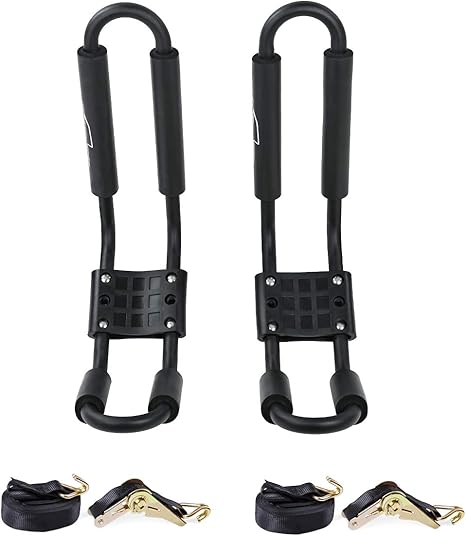
The brand may not be that well known, but know that the universal kayak/canoe roof rack is a quality product. Not only is this built up to spec to be able to carry up to 250 pounds, but it is also highly customizable which allows it to be used against both kayaks and canoes. It also comes with multiple carriage bolts and other components that can be used to attach to crossbars of different shapes and make.
Along with strength and durability, the AA-Racks J-Bar is properly padded and can be adjusted depending on the size and shape of your kayak. The base is also padded for additional protection and increased friction so that your kayaks would not move around when traveling.
The AA-Racks J-Bar is cheap and you can purchase more than one if you want to carry two kayaks on your roof. Of course, you would have to consider the width of your vehicle before doing this. The J-Bar does not fold, unfortunately, which can pose an inconvenience considering that the cradle is over a foot high. It also does not have boarding ramps so some may find it difficult to load.
For its price point, the AA-Racks Universal J-Bar is well worth the price for a no-frills product that can definitely serve its purpose. This is suitable for large kayaks and canoes as well as for those who are on a tight budget. For that reason, this item deserves a place on our list.
Specifications
- Size (inches) 17.6 x 6.8 x 6.1
- Weight (pounds) 8.35
- Style J-style
- Foldable? No
- Weight Limit (pounds) 250
Pros
- It can carry heavy loads
- It is affordable
- It fits most factory fitted crossbars
- The build is quite sturdy for the price
- Can secure most types of kayaks well
Cons
- It is quite complicated to install for amateurs
- It cannot be folded
Final Verdict
The AA-Racks J-Bar is an affordable and bare-bones approach to carrying kayaks. Those who want a transitional kayak rack can do well with this until such time that they would like to upgrade. It should be the best kayak rack if you are just starting out with carrying your kayak around, or use this as a backup that can be installed on your secondary vehicle.
11 Rhino-Rack Universal Side Loader Rack for Kayaks/Canoes
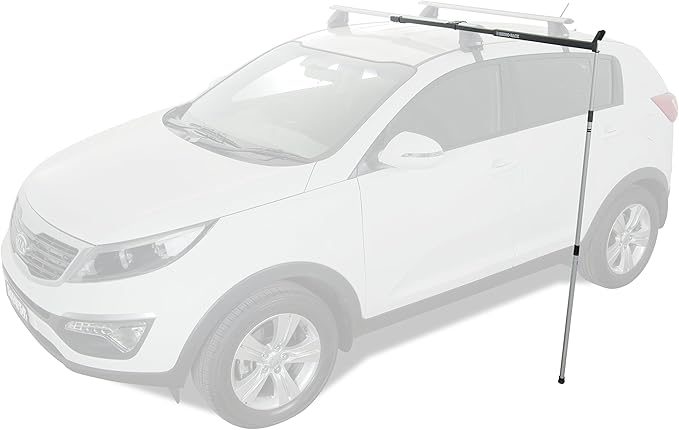
Loading or unloading your kayaks from your vehicle may be difficult, especially if you have cars with high roofs, but luckily the Rhino-Rack Universal Side Loader can help in making the task much simpler. Serving as an attachment to all types of crossbars, the Rhino-Rack Side Loader allows a person to single-handedly load even the heaviest of kayaks with ease.
The Rhino-Rack is specially designed to help you load not only kayaks but other lengthy items as well. Its durable frame allows for up to 44 pounds of weight, while support poles can increase that limit to up to 132 pounds. It is also designed to minimize slippage, which can cause injury or damages.
Sadly, that is pretty much all that the Rhino-Rack can do as it does not help when it comes to transport. It is simply a portable and efficient mechanism that allows for easier loading. While some may think that this is not worth the money, shorter people and those who are not powerful enough to lift heavier kayaks can surely benefit from this contraption.
You better use the Rhino-Rack Side Loader with temporary pads, as it might interfere with a few kayak frames. This device is also easy to use and is great for beginners that are still having trouble with handling their kayaks. While expert users may not require this, taking the Rhino-Rack along can definitely save you time and effort especially after a long tiring day of kayaking.
Specifications
- Size (inches) 41 x 4 x 7
- Weight (pounds) 10
- Style Pad/Loader
- Foldable? Yes
- Weight Limit (pounds) 132
Pros
- It is portable
- It requires no installation
- It allows for easy loading and unloading
- Support poles allow for heavier loads
- Pads protect the roof against scratches
Cons
- It is a loader only
- It may not work with other types of kayak racks
Final Verdict
To be honest, you can probably live without this product and carry your kayak without a roof rack. However, the Rhino-Rack Universal Side Loader deserved to be in our list in our opinion as it provides great convenience to those who find hauling kayaks difficult. Nevertheless, it’s an excellent product for sale.
It is a cheap and effective way to load kayaks, and it doesn’t hurt that it can be removed just as easily each time it is being used. Quick-release straps and push button locking also make it a secure way of loading kayaks without the risk of damage or injury.
Why Do You Need a Kayak Roof Rack?
Kayaks usually require a garage to be rightly homed. Out of the garage on top of a car, it also needs the right loading system to hold onto. It is called a roof rack. Simply put, it is a rack which allows you to carry a kayak on top of your car. This is different from a travel trailer that require ample space behind the car, which can make parking difficult. These trailers can also be way more expensive.
On the other hand, fishing kayak roof racks require additional vertical space, so going through areas with low ceilings may be a problem. Still, roof racks for kayaks are always better if you know how to use them properly.
Different Types of Car Top Kayak Racks
There are different types of kayak racks available, and each is suited based on different criteria. This would include what type of vehicle you have, what types of bars or racks are installed, what space is available to you, and how easy you would like to secure and remove your kayak. Remember that not every vehicle has a pre-installed rack. So, most of these racks are desined for cars without a rail or rack.
In our list, we’ve kept kayak holders for a wide range of cars, sedans, vans, minivans, RVs (bumper mount), pop up campers, UTVs, pickup trucks, cargo trucks and SUVs that include Jeep Wrangler Unlimited (hard top), Jeep Grand Cherokee, Jeep Renegade, Jeep Gladiator, Jeep Patriot, Jeep Liberty, Toyota Camry, Toyota RAV4, Tundra, Toyota Corolla, Toyota 4Runner, Mazda 3, Ford Mustang, Ford Fiesta, Ford Ranger, Ford Fusion, Ford Edge, Ford Focus, Ford F150, Volkswagen (VW) Jetta, Toyota Prius, Toyota FJ Cruiser, Toyota Tacoma, Toyota Highlander, Kia Sportage SUV, KIA Sorento, Honda CR-V, Honda Civic, Honda Accord, Honda Element, Honda Ridgeline, Honda Pilot, Hummer H3, Chevy Avalanche, Chevy Tahoe, Chevy Cruze, VOLVO, Hyundai Elantra, Nissan Juke, Nissan Xterra, Nissan Rogue, Nissan Altima, Nissan Frontier, Dodge RAM, BMW, Subaru, Chevrolet Silverado, MINI Cooper, Kia Optima, Kia Soul, GMC Canyon, GMC Terrain, and GMC Acadia.
You can either put your kayaks sideways or straight or upside down using these racks depending on the type of racks you are using. Make sure you match your vehicle type with the rack. You might need special arrangements for towing a side loading rack on a 5th wheel carrier.
Here are the most common types of car rooftop carrier for a kayak that is available, as well as brief descriptions on each.
1. Temporary Pads
Temporary pads are basically foam pads or pool noodles that you can place on top of your car to support your kayak during transport and to prevent your car from being scratched. This type of homemade DIY solution is perfect for rackless vehicles for which the owner does not want to install an external rail, but they are not so great when it comes to security. Purchase these if you don’t intend on bringing your kayak along on a regular basis.
2. Saddles
Saddles are preferred for vehicles that already have crossbars installed, and for those who will be carrying large kayaks. Saddles are basically pads that are V-shaped rather than flat, with its purpose being able to support the entire width of the kayak. This provides more support and security, especially for larger kayaks.
3. J-Cradles
J-cradles (also known as Jay hooks, J hooks or J racks) are designed with space considerations in mind, as kayaks can be loaded on a 45-degree angle instead of upright. This will allow you to put more stuff on top of your car. You can also turn this J bar into a double kayak roof rack if you want to carry more than one. They come with straps and make sure you do the strapping well. This type of kayak luggage rack is great for lighter kayaks a well as lower vehicles as carrying a kayak on its side may require more physical strength.
4. Stackers
Stacker provides ample space for stacking multiple light kayaks on your vehicle. This makes this the perfect pick if you choose two kayaks at a time, or maybe even more. Crossbar space consumed is limited, but wide kayaks cannot be secured in this way. Vertical space is also required as kayaks will be stored sideways on top of the vehicle.
5. Crossbars
Crossbars are metal bars placed parallel to the rails of the vehicle. This is where the attachments such as saddles and stackers are placed. Most roof mount brackets will require installation, although you can have aftermarket crossbars installed if you do not have one. These are usually lockable options and often come with a basket for extended loading capacity. Take note, though, that cross bars’ weight limits depend on the weight and number of kayaks that you intend to load.
6. Rollers
Rollers are systems that will help ease the loading of kayaks. As the name implies, all you have to do is place the end of your kayak on top of your roller and you can just roll it up to the rack. Rollers work in tandem kayaks with racks and cannot handle kayaks stored in a non-vertical position.
Apart from the above systems, you’ll also find ladder and hitch racks for which you wouldn’t need a lift assist, but in this guide, we’re discussing about only roof-top solutions. There are suction cup systems as well that don’t need any piercing or modification to the vehicle body.
Best Kayak Roof Racks: A Comprehensive Buying Guide
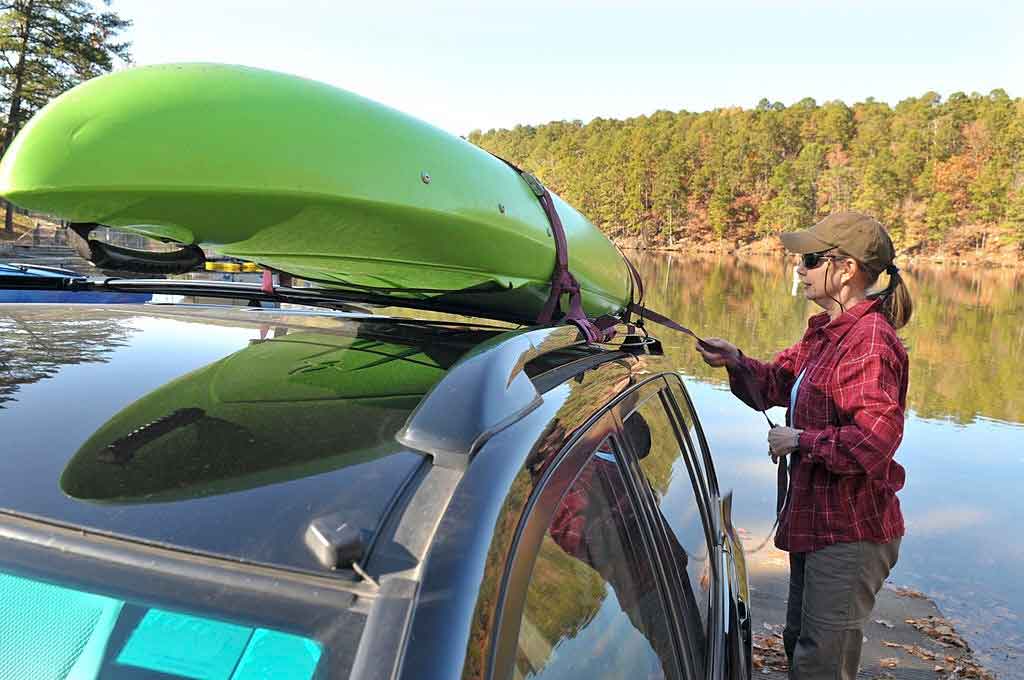
When looking for these products, know that it is not a one-size-fits-all affair. Here is a list of things you have to consider before doing your shopping around.
1. Structure of Your Vehicle’s Roof
Depending on the roof of your vehicle, you can attach different types of kayak roof racks. For bare roofs, pads are recommended, while those with rails may require to have crossbars installed if not are still available. With crossbars, you can install a removable rack or just keep them always attached if you would be using them often.
Besides, specific vehicle brands might require specific fittings, for example, you might require Honda fit racks for your Honda sedans or SUVs unless you have a universal topper.
2. Type of Your Kayak
The type of your watercraft is an important factor because it’s size and weight will determine the rack’s capability. Having a large kayak will require a rack that can accommodate not only the width but also the weight. This is especially important for smaller vehicles that may not be able to provide adequate support.
3. Your Kayaking Frequency
If you are a frequent kayaker, having your kayak racks fixed will be a nice idea. However, for those who do not frequently bring their kayaks, having racks that can be attached and detached easily will be necessary. Note that some types of racks will also need other parts of your vehicle such as windows and doors, so complicated setups done frequently can feel like a chore.
4. Features of the Racks
Some kayak racks have special features that will provide for different types of conveniences such as ease of loading and unloading, adjustments for differently sized kayaks, increased security, or added protection to your car. Look through special features and see which one appeals to you the most.
Few models could be designed for triple units but if you are careful you can add an extra. Similarly, even though these are designed for kayaks, they might be useful for bikes and other lightweight luggage.
5. Trusted Manufacturers
There are different manufacturers of kayak roof racks, from cheaper to high-end ones. Price does not necessarily mean quality, though, but it is, however, important to get racks from manufacturers that have a good reputation in the market. Our shortlisted products are from reputed brands, so you won’t have to worry about their quality.
6. Compatibility
Compatibility pertains to both the kayaks that you are loading as well as the accessories already present in your vehicle. While you can install new rails or crossbars, you should know that they should be compatible with the racks that you have your eye on.
Otherwise, you might waste your money buying something that will not fit with what you currently have. For trucks, there are specific models that are compatible for truck beds and fifth wheel camper shells.
7. Damage Protection
Kayak roof racks should provide protection to your vehicle, even under the harshest of conditions. As such, they should be able to provide adequate space between the kayaks and the cars, even if said kayaks are heavy or move around.
8. Security & Stability
Security and stability is important, especially in a moving vehicle. A secure and stable kayak rack will mean that kayaks will not dislodge, preventing accidents or injury. Racks should be stable and secure even with strong winds or when traveling at high speeds. When buying, make sure you avoid the PVC plastic materials, or else you might end up damaging both your car and the kayak.
9. Ease of Installation
A kayak rook rack, no matter how user-friendly, will need to be installed. Sometimes, they would have to be removed as well, especially if they would not be used for a long time. Having a hassle-free process to remove and install will be convenient, especially if there are no tools required and with minimal manpower required.
10. Ease of Loading & Unloading
Loading and unloading kayaks should be easy and would require as little effort as possible. This is especially important after kayaking as you may have already spent the majority of your strength. A good kayak roof rack should be convenient to use and you should be able to load and unload your kayak quickly and safely.
It’s always useful to read the instruction manual coming with each product regarding how to haul your stuffs on these racks.
Roof Racks & Rails Using Tips
While these systems can do their jobs as advertised, you should follow certain rules to get the most out of them and to ensure that your precious kayaks are safely secured throughout your trip. Follow the instructions below to assure yourself of a convenient loading and unloading process.
- Before loading, check that all screws and straps are tightly secured.
- Ensure that foam pads are placed where the kayak will make contact with any surface of the carrier or vehicle.
- Use additional foam pads if necessary.
- Attach straps tightly and securely. If needed, add pads on points of contact as well.
- Add straps aside from the ones included in the package if necessary.
- Drive carefully and take into consideration the added size and weight of your vehicle.
It is also important to consider purchasing the right racks for your vehicle, your crossbars, as well as the kayaks that you will be loading. That is what this review is for. If still in doubt, you can ask manufacturers or online community boards for the product that will fit your requirements for a safe and worry-free journey.
Final Words
Here, we have provided you with a comprehensive list of the best kayak roof racks available to you today. Hopefully, our reviews would have provided you with all of the information that you need about kayak roof racks and which ones you should be shopping for.
Our personal favorites in this list are the Thule 898 Hullavator and the Yakima Jaylow, the former for its ease of loading and unloading, and the latter for its flexibility to switch between J-style and stacker modes.
Of course, you might have your own preferred racks included within the list, and maybe even those who have not made the cut. The bottom line is, you should definitely go with the products that you want, although knowledge on what works and what does not will help you make an informed buying decision.
FAQ
1. Can I put a roof rack on my car?
Ans. You can always put a roof rack on your car to carry not just kayaks but also other stuff and luggage.
2. How far apart should kayak racks be?
Ans. Put them in between 28 to 30 inches apart from each other. It also depends on the size and number of your kayaks that you want to carry.
3. Can I use a roof rack without crossbars?
Ans. Well, crossbars will ensure more space to stack your kayaks securely, whereas only roof racks are good for luggage and other smaller stuff.
4. What is the difference between roof rails and roof racks?
Ans. The main difference is that the rails are installed along the length of the car. On the other hand, roof racks are installed across the car’s roof.
5. How do you secure a kayak to a roof rack?
Ans. Use ropes or belts of the rack to tie the kayaks with the rack. You can put the kayaks either face up or face down depending on the convenience.
6. How much weight can I put on the roof of my car?
Ans. We would suggest not to put more than 170 pounds on the roof of your car or SUV.
7. Can you put 2 kayaks on top of a car?
Ans. Yes, you can put two kayaks on top of your car. Depending on the size of your kayak, you can even stack 3 of them if you can.

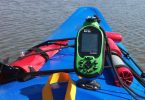

Leave a Comment